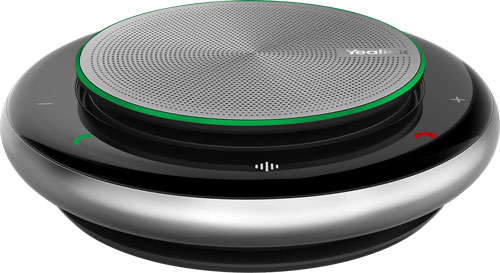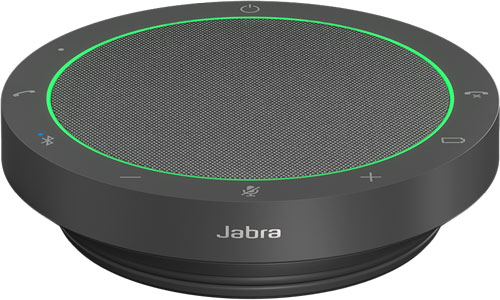Video conferencing is the most natural form of distant communications we’ve developed so far. When you want to establish a professional video conferencing space with pro-level video and audio, there are many devices that might help.
Take speakerphones.
A convenient device for improving audio quality on video calls is the speakerphone, often called a speaker puck because many of them resemble hockey pucks. We’re not talking about the built-in speakerphones you find in your desk phone or smartphone; we’re talking about the separate device.
Speakerphones work as both speaker and microphone in one device, are simple to use, are interoperable with pretty much any platform, and feature audio-enhancing technologies for professional sound quality. Most feature 360° audio pickup using microphone arrays. Many are built for portability.
Because they’re so interoperable, they’re great solutions for BYOD video conferencing. There are also Microsoft Teams versions of many speakerphones, which natively integrate with that platform and have a dedicated Teams button.
Speakerphones are great, but they’re not universal solutions for video meeting rooms.
In this blog, we cover when you’d want to consider a speakerphone for audio on video call.
So where do you use a speakerphone for video conferencing?
There are three video conferencing scenarios where speakerphones really shine:
- Speakerphones for video conferencing in huddle rooms and focus rooms
- Speakerphones for impromptu video conferences, including while traveling
- Speakerphones for personal use
We’re going to cover each of these scenarios in turn.
But first, a few words about speakerphone connectivity that you should know.
Professional speakerphones connect in two ways: wireless Bluetooth and wired USB. Many speakerphones, like Poly Sync 40, support connecting in both ways.
Speakerphone connectivity type is pretty much down to personal preference. If you plan on using a speakerphone with your smartphone for on-the-go conferencing in a hotel room, you’ll probably want to use Bluetooth. If you plan on using one with your laptop in a huddle room, you’ll probably want to use USB.
The key thing here is: make sure that the speakerphone connects to your devices. That includes ensuring that the USB cable has the correct USB plug type — USB-A or USB-C — and that, if you want to use Bluetooth with a computer, you have the correct Bluetooth adapter for enabling wireless connectivity. Thankfully, most Bluetooth speakerphones come with a Bluetooth dongle for this purpose.
Bluetooth and USB are both supported by basically every device that you’d use a speakerphone with.
So now you know how to find a speakerphone that works with your devices.
Let’s get into when you want to use a speakerphone for video conferencing!

Video Conferencing Speakerphones for Huddle Rooms
Huddle rooms are the perfect space to use a speakerphone in.
What is a huddle room? A huddle room is an extra-small conference room — that’s it. It’s a meeting room for up to 4 or 5 people. You might see the term focus room, which means basically the same thing.
A typical video conferencing system for a huddle room will have a small table — maybe even just a coffee table — with a display at one end. The most common video device for huddle rooms is the video bar, which combines a camera, microphone, speaker, and often codec in one device.
If you’d like to know more about video bars, check out our expert, detailed Video Bars Buyer’s Guide.
Video bars already have microphones in them.
But many companies want to use webcams. And this is where speakerphones shine. Webcams are USB video conferencing cameras for personal use or small spaces. (There’s no hard and fast distinction between “webcam” and “video conferencing camera.”)
While some webcams have built-in microphones, these are almost universally of poor quality. And for sure if you have a group of people, a webcam microphone won’t cut the mustard.
Enter the speakerphone, which is designed for group calls. You get the convenience of a webcam with greatly improved audio quality. And set up remains super simple.
With a webcam-based video conferencing setup in a huddle room, the camera will likely be connected to a laptop that someone brings in to run a video conferencing application like Microsoft Teams or Zoom. To use a webcam, you just select it as a video peripheral in the app’s settings.
It’s the same process for a speakerphone: plug it into the laptop, go into settings of the meeting app, and select it as the audio peripheral as both microphone and speaker.
You can plug a wired USB speakerphone directly into the laptop or use a wireless Bluetooth speakerphone by plugging its dongle into the laptop. You might prefer a Bluetooth speakerphone in the case of a huddle room, because it makes positioning it simpler.
The whole process is very easy and establishes a professional video call experience.
The same process can work if you use a video bar in a huddle room. A video bar is a device that combines camera, microphone, speaker, and often codec. A video bar for huddle rooms like Poly Studio V12 provide an all-in-one professional solution that’s more of a permanent, installed solution than a speakerphone.

Video Conferencing Speakerphones for Impromptu Calls
One of the biggest advantages of a speakerphone is its portability. And portability means they’re great for unplanned situations.
Impromptu video conferences can take place in the office — gather your team for a quick call — or on the road.
For impromptu office calls, the set up will be very similar to what we described in the huddle room: a webcam for video and a speakerphone for audio.
You’ll want to look for a speakerphone that has advanced noise-cancelling technologies and beamforming microphone arrays. Impromptu video calls are more likely to be in public spaces or spaces where there will be more disturbances than video calls that take place in dedicated meeting rooms. That’s why you want noise cancellation.
Beamforming microphone arrays use minute changes in pressure to locate where a sound is coming from, then focus in on that source. With a speakerphone, beamforming means it will focus in on the active speaker’s voice, rather than indiscriminately picking up sound from all directions. So beamforming microphones are another form of noise cancellation.
Impromptu video calls also happen outside the office.
With on-the-go video calls, you’ll want a speakerphone that’s designed for portability, like Jabra Speak2 55, which is IP64-rated against dust and water ingress and comes with a carry pouch.
You can use a portable speakerphone with your laptop, so even if you don’t have a webcam to improve video quality, you’ll still get professional audio quality. If you’re with a group of people, a speakerphone is particularly important to have, because built-in computer microphones aren’t designed for group voice pickup.
You can also use a portable Bluetooth speakerphone with a smartphone or tablet. This gets us to personal speakerphones for video conferencing.

Video Conferencing Speakerphones for Personal Use
By personal video conferencing, all we mean is that your end of the video call is just you. You’re not in a group, even if the other end is a group.
You’ll be using either the camera that comes built into your computer or monitor for video, or a personal webcam. But you’ll need that audio peripheral to make sure you sound your best.
If speakerphones are mostly designed for groups, why would you use one for just yourself? There are a number of reasons.
They improve audio quality compared with the average computer. That’s a good reason right there.
Speakerphones are really easy to use, so you don’t need to worry about complex microphone set ups like a podcaster would use.
They let you keep your hands free for typing or writing while you talk.
Some people don’t like wearing headsets, which also improve audio, so a speakerphone is a great option.
Many people prefer to use a speakerphone generally — just think about how many people you see walking around in public or sitting on a bus with their personal calls on speakerphone. With a personal speakerphone, you gain that experience while maintaining professional audio standards.
For personal speakerphones from business-class manufacturers (like all the ones we sell), the only considerations you really need to worry about beyond style are platform compatibility and device connectivity.

